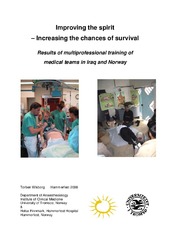Diagnostics and management of infective endocarditis post-transcatheter aortic valve implantation - A systematic review
Permanent link
https://hdl.handle.net/10037/25313Date
2021-05-31Type
Master thesisMastergradsoppgave
Author
Martyn, Piriyanthi CaroliniAbstract
Background: As transcatheter aortic valve implantation (TAVI) has expanded the treatment options to otherwise inoperable patients, it has become as prevalent as surgical aortic valve replacement. TAVI infective endocarditis (IE) has thereby become a feared complication. IE is heterogenous in its presentation, identifying characteristics and diagnostic criteria among these patients is crucial in diagnosing IE. Treatment entails a conventional approach with antibiotics or in combination with surgery. Treatment option for TAVI IE is highly debated in high-risk patients. The primary aim of this systematic review is to find knowledge on how TAVI IE patients are diagnosed and treated as stated in the literature.
Method: Records were searched in MEDLINE and EMBACE. The search strategy is based on how TAVI IE is diagnosed, clinical presentation, treatment, and outcome. EndNote, Rayyan and EPPI-REVIEWER were used in the process of screening and selecting studies. All studies were first assessed by titles and abstracts, then selected articles in full text against the inclusion criteria. All disagreements between the (three) researchers were discussed until agreement.
Results: Final selection process left us with 16 empirical retrospective/prospective studies and 51 case studies, between year 2005-2019.
Conclusion: Diagnosing TAVI IE is based on the modified duke criteria’s (MDC), where pathological findings and clinical judgement are the cornerstone. This review indicates a rise of enterococci as the causative microorganism for TAVI IE, while the common first symptoms recognized are fever, heart failure and systolic murmur. Treatment choice for TAVI IE should be a case-by-case decision based on clinical judgment and managed individually. Studies included in this review indicate that surgical option as a treatment to TAVI IE should be reserved for complicated and life‐threatening cases. Unfortunately, there are not enough studies/data to determine whether surgery or antibiotics are appropriate and when.
Publisher
UiT Norges arktiske universitetUiT The Arctic University of Norway
Metadata
Show full item recordCollections
- Mastergradsoppgaver Helsefak [1337]
Copyright 2021 The Author(s)
The following license file are associated with this item:
Except where otherwise noted, this item's license is described as Attribution-NonCommercial-ShareAlike 4.0 International (CC BY-NC-SA 4.0)
Related items
Showing items related by title, author, creator and subject.
-
The Temporomandibular Joint in Juvenile Idiopathic Arthritis, focusing on Quality of Life, Oral Microbiome and Intervention
Frid, Paula (Doctoral thesis; Doktorgradsavhandling, 2020-10-02)The temporomandibular joint (TMJ) is commonly involved in juvenile idiopathic arthritis (JIA), and may lead to impaired mouth opening, pain and facial growth disturbances. Asymptomatic TMJ arthritis may be diagnosed late in the disease course, thus management is challenging. The overall objectives of this thesis were to provide new knowledge on quality of life (QoL), the oral microbiome and interventions ... -
Studies of sleep and seasonal variations in patients with chronic musculoskeletal pain
Abeler, Karin (Doctoral thesis; Doktorgradsavhandling, 2021-04-19)<p><i>Background/aims:</i> Chronic pain is a major health problem, and contributing factors include poor sleep and mental distress. In the subarctic city of Tromsø, clinical impression also suggests worse pain in winter. We aimed to examine whether sleep in patients with chronic musculoskeletal pain differs from pain-free controls, and how psychological processes are related to sleep in these groups. ... -
Improving the spirit – increasing the chances of survival : results of multiprofessional training of medical teams in Iraq and Norway
Wisborg, Torben (Doctoral thesis; Doktorgradsavhandling, 2008-05-30)This work is a synthesis of experiences gained during ten years of helping healthcare providers improve their service to victims of injury and acute disease. This work is based on my participation in two programs: The Trauma Care Foundation’s Mine Injury Management Program in Kurdistan, northern Iraq, and the BEST Foundation: Better & Systematic Trauma Care’s trauma team training program in Norwegian ...


 English
English norsk
norsk



